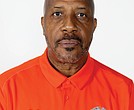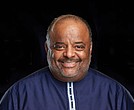Rev. Barber’s new book demystifies poverty: Black people are not the problem
Yonat Shimron/Religion News Service | 8/1/2024, 6 p.m.

When Tim Tyson first invited the Rev. William Barber II to meet with a group of white residents of Mitchell County, in North Carolina’s Blue Ridge Mountains, Barber half jokingly replied, “I knew you were gonna get me killed.”
Barber, a Black anti-poverty activist, knew that in 1923 nearly all the county’s Black residents were driven out of Mitchell County. Even in 2013, when the invitation was extended, the county had fewer than 100 Black residents out of 15,000 people, or less than 1%.
But Tyson, a historian who teaches at the Center for Documentary Studies at Duke University, convinced Barber to trek up the mountain to meet a group of white citizens who were fed up with the state legislature’s cost cutting, especially in public education.
What Barber found at an Episcopal church in Mitchell County were a group of like-minded working-class white people eager to hear his message.
“There were about 300 people there standing all along the walls and Rev. Barber just spoke to them from his heart and spoke from his faith,” said Tyson. “He got three standing ovations. People just wept. They were so touched.”
When it was over, the assembled crowd said they wanted to start a branch of the NAACP — even though they were all white.
It was then that Barber first realized he could not be a moral leader and stand up only for Black people. Many white people too are poor and struggling. In fact, they form the largest single demographic group of the estimated 40 million Americans who are poor according to the U.S. Census, which Barber considers an outdated and significant undercount.
That trip up to Mitchell County convinced Barber that he ought to follow in the tradition of the biblical prophet Jeremiah, who was called to be a watchman. “The ancient prophets remind us that when we cannot see a problem, a watchman must sound the alarm.”
As he outlines in his new book, written with Jonathan Wilson-Hartgrove, who is white, it’s time for poor Black people, white people and other minorities to unite and fight for better living conditions.
In “White Poverty: How Exposing Myths About Race and Class Can Reconstruct American Democracy,” Barber and Wilson-Hartgrove urge an end to the political ploys that set poor Black people against poor white people.
“The history of America, like the history of the world,” Barber writes, “is filled with stories of powerful people who’ve stolen from the poor and used their power to pit poor people against one another so the masses would not rise up against them.”
As an example, he notes how Republican politicians have portrayed government programs such as welfare benefits as handouts from hard-working white people to poor Black people, even though more white people benefit from those programs than Black people.
Attacks on diversity, equity and inclusion programs are another recent example experts point to as conservatives trying to use racial resentment to undermine class solidarity.
“This is the longest power play in the U.S. South, certainly, but across America: to divide people whose interests are shared and whose needs are very painful and urgent, by race,” said Nancy MacLean, a historian at Duke University who has become an ally of Barber’s and whose work is cited in his book.
As he has before, with his Poor People’s Campaign, Barber is calling for a “Third Reconstruction.” The first was the work of the Reconstruction era after the Civil War that guaranteed the rights of former slaves with the 13th, 14th and 15th amendments to the Constitution. The second was the Civil Rights Movement that ended formal segregation, dismantled Jim Crow and removed legal barriers to voting.
For Barber, white people uniting with Black people to fight poverty is the work of the Third Reconstruction, informed by a deeply moral and Christian mandate.
Before talking to a group of white people up in Mitchell County a decade ago, he had them sing a hymn, “Blessed Be the Tie That Binds.” Reference to that hymn is repeated throughout his new book.
“In communities across the land, I’ve had the opportunity to see and touch the ties that bind poor people,” he writes. “These are my people, just as much as the multicolored ancestors my daddy taught me to remember. … I am a witness that every shade of America’s poor has a great deal in common.”




